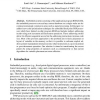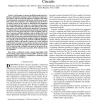1003 search results - page 103 / 201 » How to Parallelize Sequential Processes |
PODC
1997
ACM
14 years 1 months ago
1997
ACM
Conditions on a shared object type T are given that are both necessary and sufficient for wait-free n-process consensus to be solvable using objects of type T and registers. The co...
HIPC
2000
Springer
14 years 15 days ago
2000
Springer
Embedded systems consisting of the application program ROM, RAM, the embedded processor core and any custom hardware on a single wafer are becoming increasingly common in areas suc...
AMC
2007
13 years 9 months ago
2007
Abstract–A new evolutionary programming algorithm (NEP) using the non-uniform mutation operator instead of Gaussian or Cauchy mutation operators is proposed. NEP has the merits o...
TEC
2002
13 years 8 months ago
2002
Abstract--In this paper, we present an efficient graph-based evolutionary optimization technique called evolutionary graph generation (EGG) and the proposed approach is applied to ...
ASPDAC
2010
ACM
13 years 7 months ago
2010
ACM
- The design of embedded computing systems faces a serious productivity gap due to the increasing complexity of their hardware and software components. One solution to address this...


